Designing Tattoos with a Neural Network
Abstract
Tattoos are personal, permanent, and pretty hard to design. While it’s exciting to engage in the intimate process of working with a tattoo artist to help design a tattoo, that process can take a long time and cost a lot of money. Tattoo creation by neural network (NN) is an interesting problem to address, especially as it has barely been done before. We collected images (n=936) to create three tattoo datasets–black-white, colorful, and combined–by scraping images from Google Images. We also utilized and modified an existing DCGAN that generates facial images, based on its Pytorch tutorial, to generate tattoo images. All three datasets tended to generate similar images in that generated images often shared similar colors and shapes. We modified the hyperparameters and had the best results with learning rate of 0.0005, batch size of 32 and various numbers of epochs. However, none of the results were satisfactory enough to be accounted as successful. We suspect that the relatively small size of the tattoo dataset mainly attributes to the drop down of performance. During the project, various ethical concerns were raised, and we outlayed eight main concerns spanning from copyrights to offensive images and skin color for tattoos. Future work would be to better develop the model to account for the tattoos depicted on human skin and to better clean up our initial database, among others.
Introduction
Tattoos are personal, permanent, and pretty hard to design. While it’s exciting to engage in the intimate process of working with a tattoo artist to help design a tattoo, that process can take a long time and cost a lot of money. It’s common to get inspiration from images of tattoos online, but what if you don’t want a design that’s trending? Where do you go if you want to design something that is completely unique? Consider consulting a neural network.
Current art generators can produce tattoo recommendations, though they may look unrealistic and intimidating due to an emphasis on artistic value over reasonable tattoo recommendations. There do exist, however, several implementations of tattoo-specific generative models. These models are built on generative adversarial networks (GANs) which produce a collection of unique tattoos after being trained on an input dataset of tattoo images scraped from various websites. GANs are a class of machine learning frameworks in which two different networks–Generator and Discriminator–compete with each other in the form of a zero-sum game, where one network’s gain is another network’s loss. Given a training set, this technique learns to generate new data with the same statistics as the training set. The core idea is based on the “indirect” training through the discriminator which can tell how “realistic” the input seems, which itself is also being updated dynamically. Thus, the generator is not trained to fool the discriminator. We aim to train an existing Deep Convolution GAN (DCGAN) model [5], which is a type of a GAN, using FastAI to create a dataset of tattoo images.
This is an important area of research because 36% of young adults in the United States have tattoos [1]. This is a large number, but consider the many more people who might be considering getting a tattoo but haven’t yet and might benefit from unique inspiration. This is also a difficult area of research because of the controversies around using generative models for art. Many artists have expressed frustration with these models for mimicking their work, raising questions about the ethics of producing images and about what unique artwork actually is.
Tattoo creation by neural network (NN) is an interesting problem to address, especially as it has barely been done before. There are many models which have been trained using different artwork, and can create an original product. However, models have been rarely trained solely on images of tattoos, either cleaned pictures of tattoos or not-including skin and other background components. Our research found only two people who attempted such a project, but their models have not been widely used, if at all beyond personal purposes. Moreover, tattoo generation is complicated due to the various ethical issues involved, as outlined in the ethics section. Therefore, we would like to try and create a new model that will enable better results in the long run. This requires research on different types of NNs (GANs, Stable Diffusion for example) and creating a new model that will effectively comply with our demands.
To make the generated tattoo images more realistic, we will augment traditional image generation NNs with parameters like color, simplicity of the style, location, and size.
The technical challenges of this project will be to learn how to implement a working NN. Creating a model from scratch will be difficult to learn as students with minimal exposure to NNs, however will be vital in strengthening our understanding of deep learning concepts. Our team aims to be able to train a basic NN model which will use AI-scraped data. We expect that scraping such data may prove to be difficult, and may face challenges such as size, quality, and quantity when it comes to finding tattoo images. In other words, using fastAI, we will be able to find images of tattoos but are concerned about where and how to crop the resulting images and if enough images of tattoos exist publicly.
This model will potentially be capable of recommending images from the generated database. The team will cite and research other GAN models when producing their own original model. It is unclear whether a tangible output will be feasible for our project.
This project will build a tattoo generation model based on original architecture. The generator will be built toward the capability to produce tattoos (image) based upon user input (text) while producing uniquely designed art which attempts to avoid plagiarism of other artistic works. The model will provide one option per user request; if time permits, will be extended to more.
Related Works
There are several current generative tattoo models that utilize neural nets to produce unique tattoo images.
Tattoodo, an online platform developed by Vuksic, utilized neural networks to recognize and classify different tattoo styles, offering users personalized tattoo feed based on preferred artists, styles (such as tribal, water color, or traditional), and motifs (such as flora, swords, or dragons). Developers used a deep learning network called Caffe along with Nvidia’s Deep Learning GPU Training System to train the neural network. DALL-E2, a neural network created by OpenAI that “turns natural human language into realistic photos and art” [2] has been used by people to design tattoos as well.
In his 2020 Medium post Vasily Betin[3] describes how his love for tattoos and technology led him to create his own tattoo generation model. He outlines how he created his dataset of images of tattoos by scraping Instagram and Pinterest, cleaned the data, trained the network on low then high resolution images, and then continued to upscale and perfect the model. After generating over 2,000 images, Vasily chose his favorites and actually got one tattooed on his arm. The model is released on RunwayML with a public Github Repo.
 Fig 1. Screenshot from the training process of Vasily Betin’s tattoo generator [3]
Fig 1. Screenshot from the training process of Vasily Betin’s tattoo generator [3]
Methods
Our methods for this project fell into two major steps. First, we collected images to create three different tattoo datasets. Second, we utilized and modified an existing GAN that generated facial images, to generate tattoo images.
One of the challenges we faced when initially collecting our data was that the scraped images had varying backgrounds which made it difficult to isolate the data we actually needed. For example, tattoo images may appear on body parts or on a plain white background. We planned to address this problem by collecting data with white backgrounds selectively, but not only.
We created our dataset by scraping images from Google Images using Google Extensions such as TabSave and WebScraper. We separated images into three datasets. We separated images into three datasets. First, we created a dataset of 346 images containing only black tattoo artwork on white background (BW set). Second, we created a dataset of 591 images containing real tattoos on various parts of the human body (colorful set). Third, we combined these two datasets into a final dataset of 937 images (combined set).
For our model, we used a Pytorch tutorial to implement an existing DCGAN model. We added our own dataset folder called data_t (t for tattoo) and made adjustments to the code, as can be seen in our nn-tattoo-project-code github page. We trained the model separately on three datasets: clean black-over-white tattoo designs, colorful tattoo images which might also include background and skin, and the combined dataset. Along the runs we fine-tuned the hyperparameters, including epochs, learning rate, generator, discriminator, and batch size to get to the best results we can within our data set and time constraints.
Lastly, we created a web application for our NN. We used Gradio to visualize the results we get. The interface contained a sliding bar to choose a seed, which is used to fix the random generation of a group of pictures. If we wanted to reproduce the group of pictures, we could pass in the same seed to the interface. The user can simply choose a seed and hit the button “Submit”, 64 tattoo images generated by the NN will appear on the right.
Results
We trained our GAN separately on three datasets: colored images, black and white images, and the combined set of both.
Our model produced the best results when training the model using the black and white dataset. We found that when using too low of a learning rate, the model produced unsatisfactory results, and we ultimately landed on a learning rate of 0.0005. Decreasing the batch size and increasing the number of epochs improved the results, to an extent. Our team found that using a consistent learning rate of 0.0005, along with a batch size of 32 resulted in the best results for our model. Running 200 epochs versus 1000 epochs on the black and white images produced better results when using 200 epochs for the model. Running the model on colored images produced the best results when using 200 epochs, and using 1000 epochs in the model was worse than when using 500 epochs in the model for the colored tattoo image dataset. When running the model on the combined images of black and white and colored tattoo images, the model again produced the best results when using 200 epochs and had progressively worse results when using 500 and 1000 epochs in the model. In conclusion, the model produced the best results when training with a batch size of 32, 200 epochs, and a learning rate of 0.0005 on the black and white images dataset.
Selected Results:
BW Dataset
 Fig 2. Training vs produced images with the following specifications: trained on the BW dataset, batch size 32, 200 epochs, 0.0005 learning rate, 345 images
Fig 2. Training vs produced images with the following specifications: trained on the BW dataset, batch size 32, 200 epochs, 0.0005 learning rate, 345 images
 Fig 3. Training vs produced images with the following specifications: trained on the BW dataset, batch size 32, 500 epochs, 0.0005 learning rate, 345 images
Fig 3. Training vs produced images with the following specifications: trained on the BW dataset, batch size 32, 500 epochs, 0.0005 learning rate, 345 images
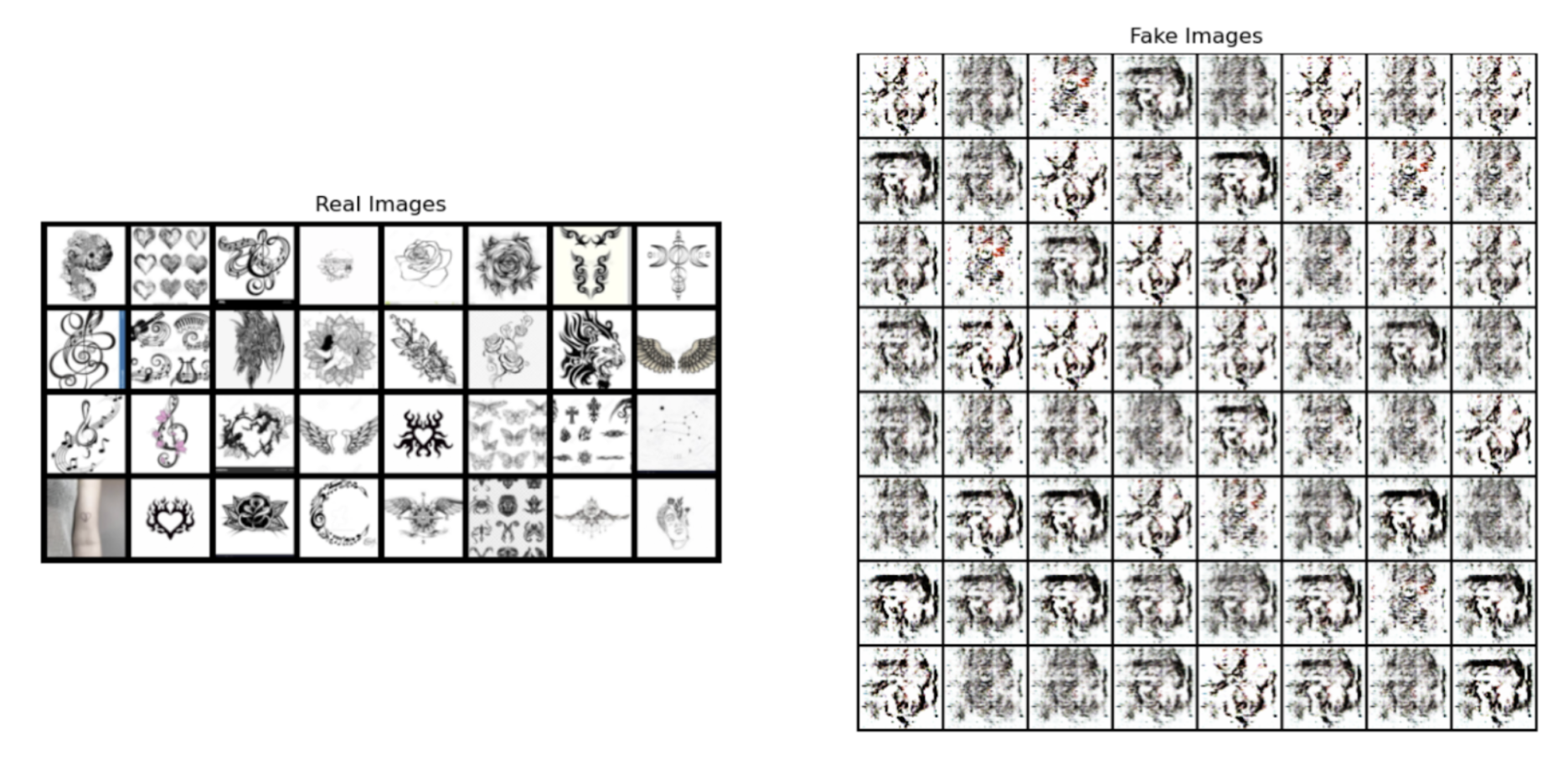 Fig 4. Training vs produced images with the following specifications: trained on the BW dataset, batch size 32, 1000 epochs, 0.0005 learning rate, 345 images
Fig 4. Training vs produced images with the following specifications: trained on the BW dataset, batch size 32, 1000 epochs, 0.0005 learning rate, 345 images
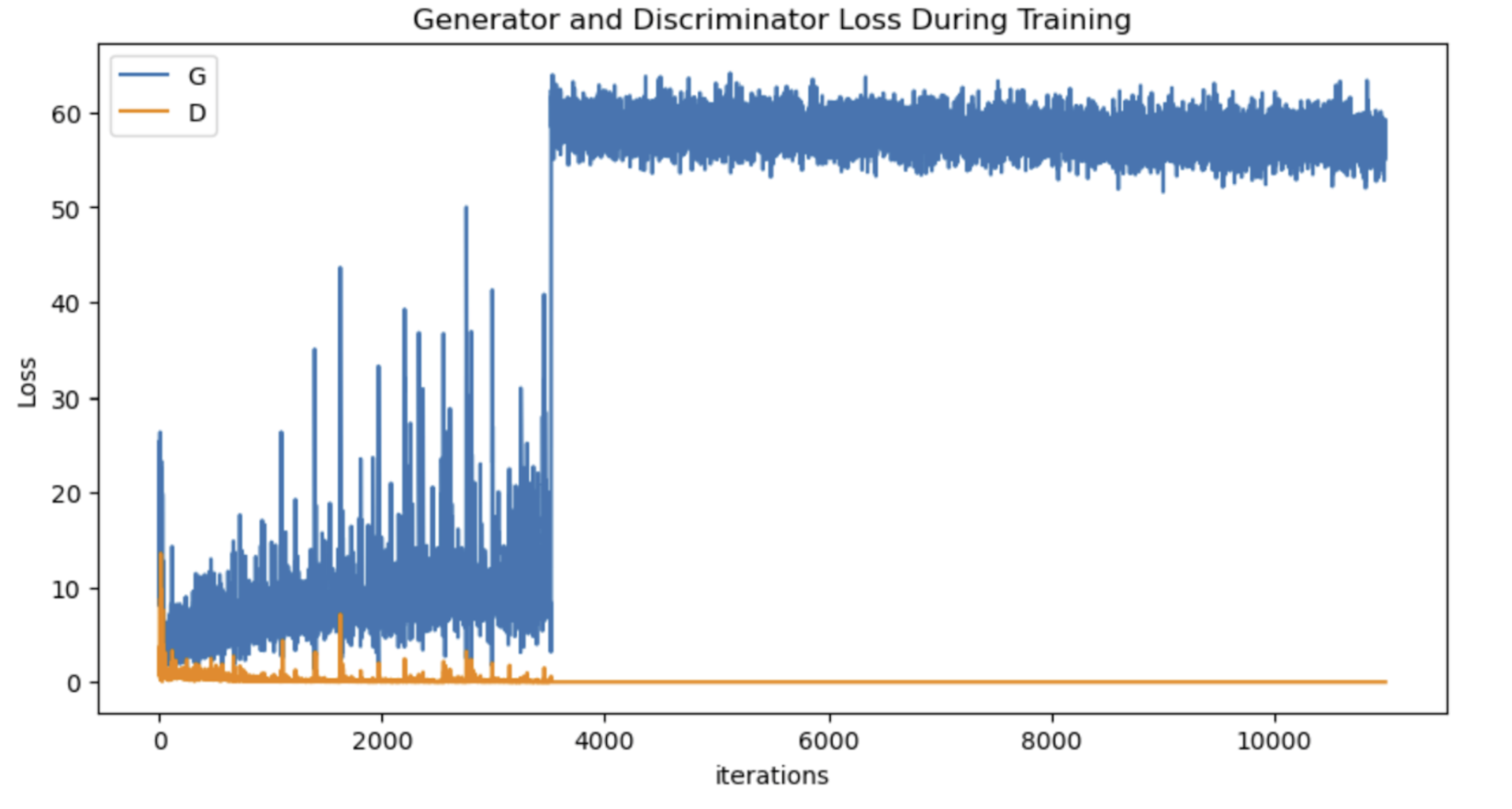 Fig 5. Generator and Discriminator Loss during training for the following specifications: trained on the BW dataset, batch size 32, 1000 epochs, 0.0005 learning rate, 345 images
Fig 5. Generator and Discriminator Loss during training for the following specifications: trained on the BW dataset, batch size 32, 1000 epochs, 0.0005 learning rate, 345 images
Colored Dataset
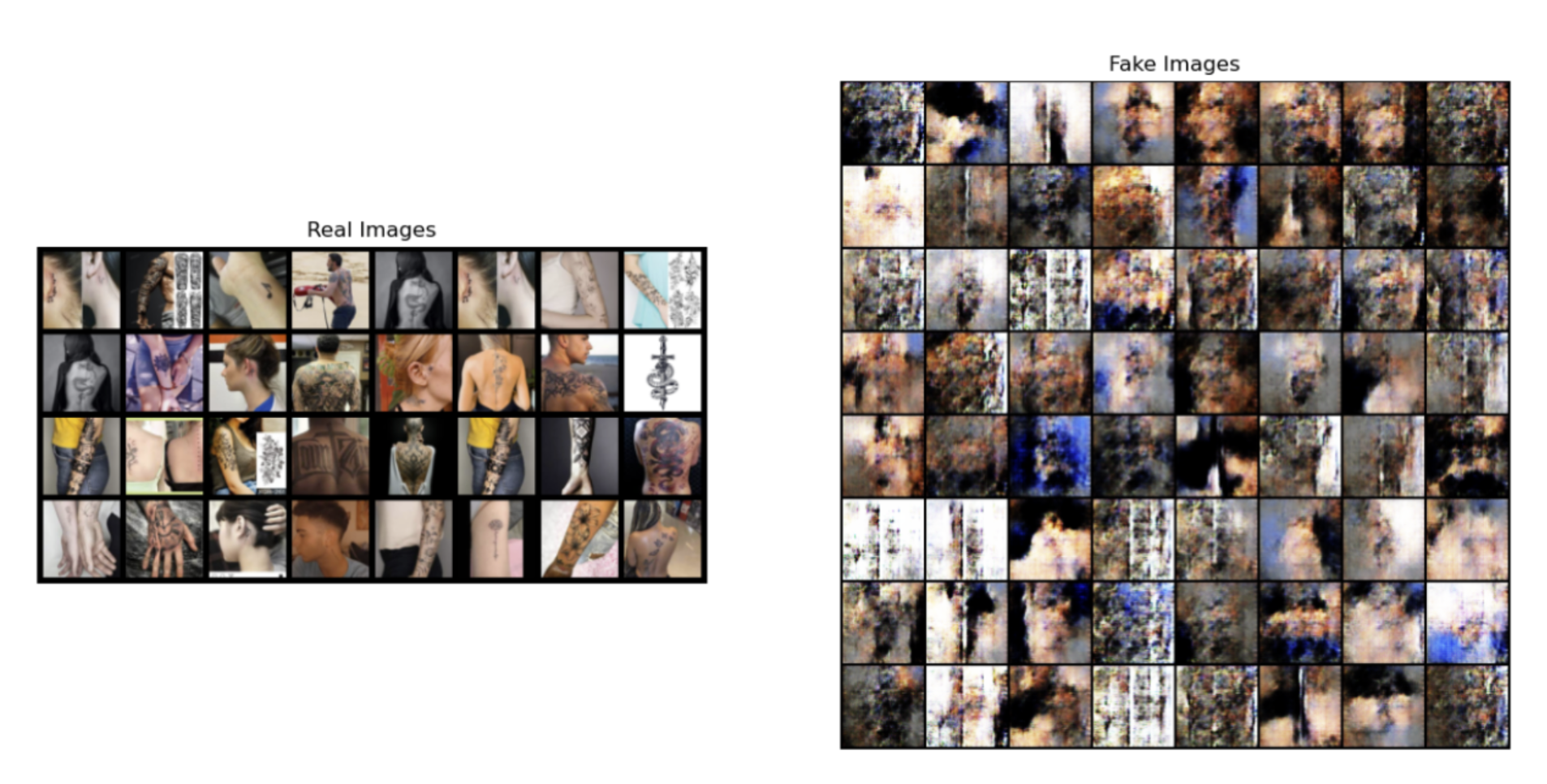 Fig 6. Training vs produced images with the following specifications: trained on the colored dataset, batch size 32, 200 epochs, 0.0005 learning rate, 591 images
Fig 6. Training vs produced images with the following specifications: trained on the colored dataset, batch size 32, 200 epochs, 0.0005 learning rate, 591 images
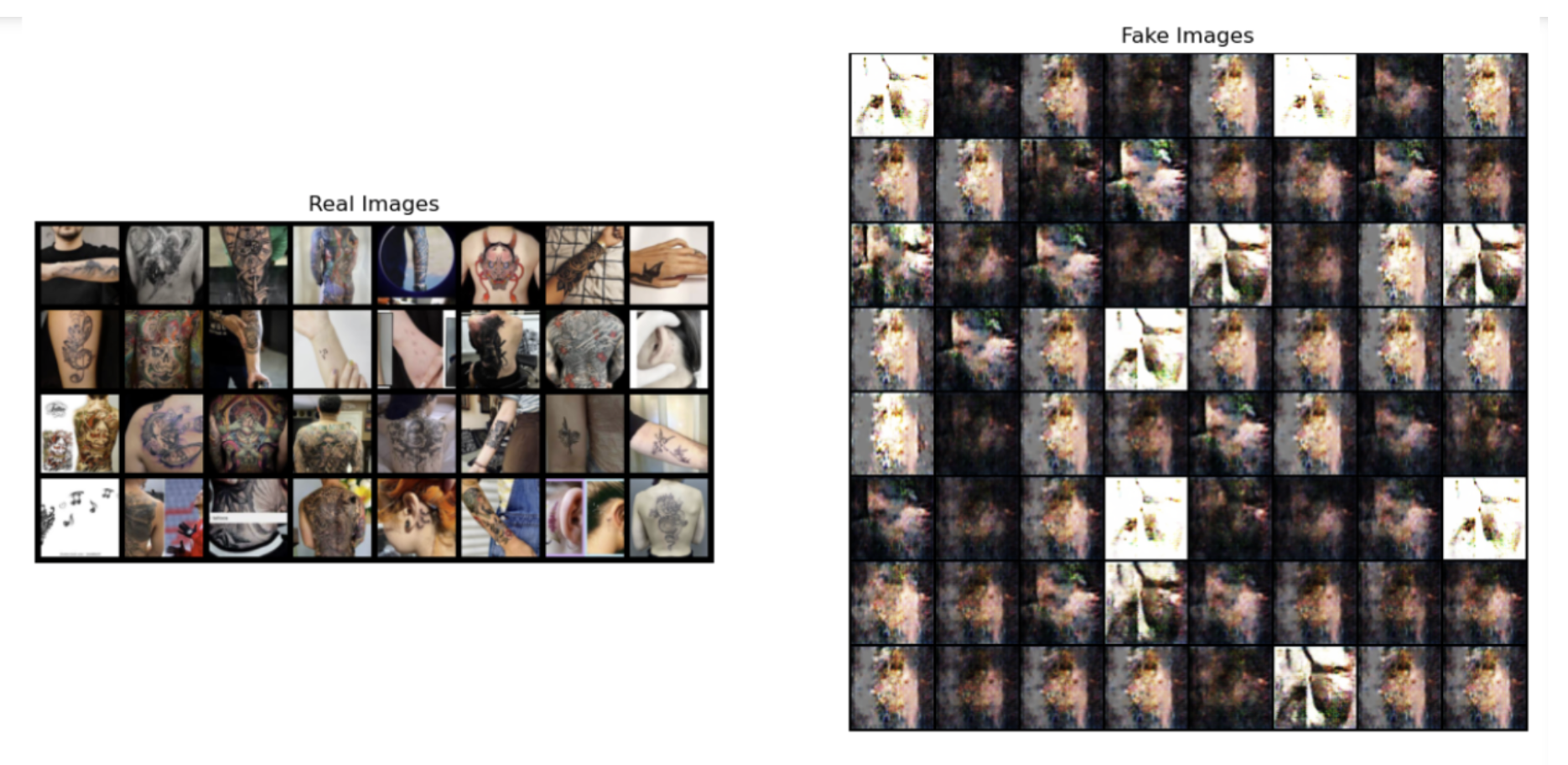 Fig 7. Training vs produced images with the following specifications: trained on the colored dataset, batch size 32, 500 epochs, 0.0005 learning rate, 591 images
Fig 7. Training vs produced images with the following specifications: trained on the colored dataset, batch size 32, 500 epochs, 0.0005 learning rate, 591 images
 Fig 8. Training vs produced images with the following specifications: trained on the colored dataset, batch size 32, 1000 epochs, 0.0005 learning rate, 591 images
Fig 8. Training vs produced images with the following specifications: trained on the colored dataset, batch size 32, 1000 epochs, 0.0005 learning rate, 591 images
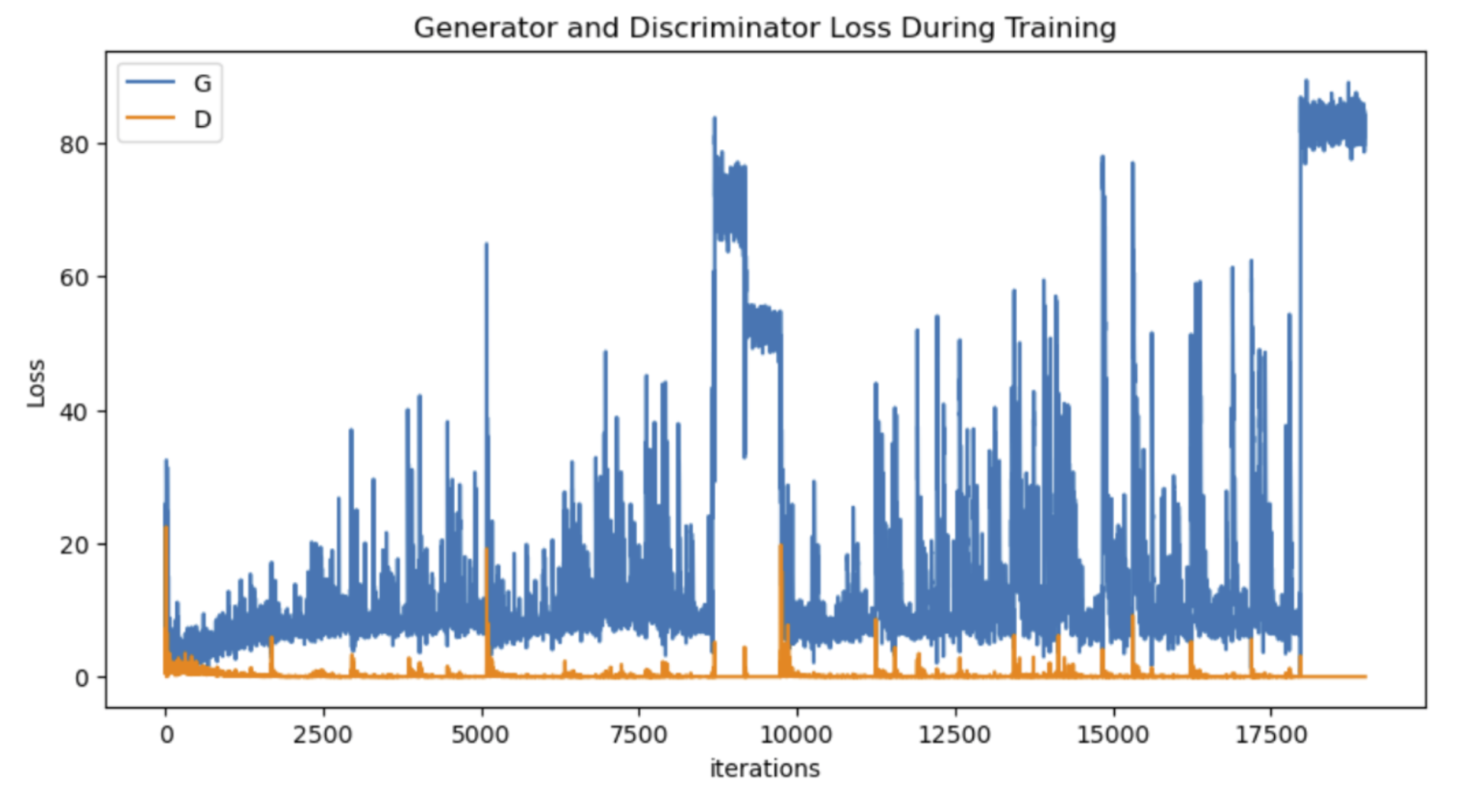 Fig 9. Generator and Discriminator Loss during training for the following specifications: trained on the BW dataset, batch size 32, 1000 epochs, 0.0005 learning rate, 591 images
Fig 9. Generator and Discriminator Loss during training for the following specifications: trained on the BW dataset, batch size 32, 1000 epochs, 0.0005 learning rate, 591 images
Combined Datset
 Fig 10. Training vs produced images with the following specifications: trained on the combined dataset, batch size 32, 200 epochs, 0.0005 learning rate, 936 images
Fig 10. Training vs produced images with the following specifications: trained on the combined dataset, batch size 32, 200 epochs, 0.0005 learning rate, 936 images
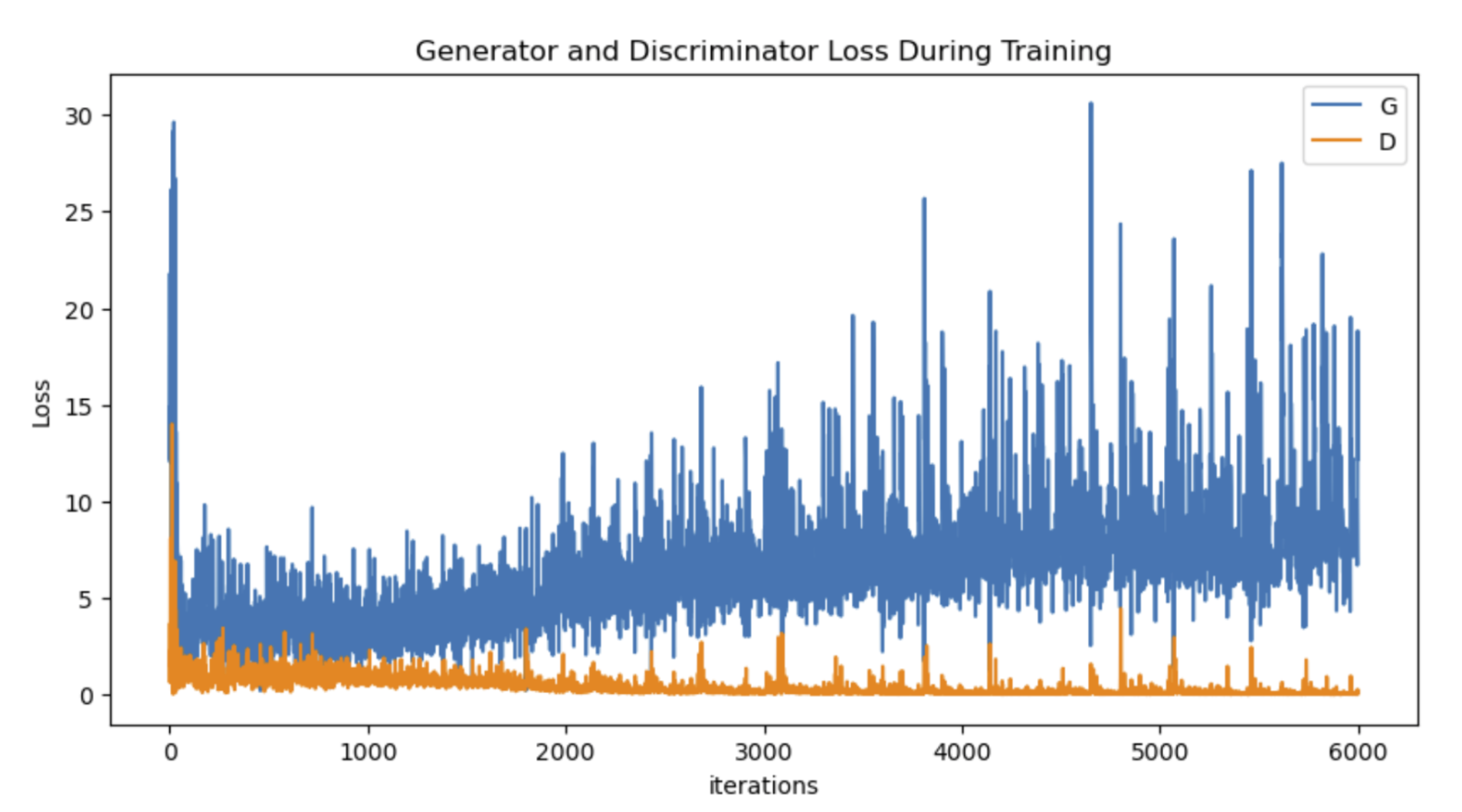 Fig 11. Generator and Discriminator Loss during training for the following specifications: trained on the combined dataset, batch size 32, 200 epochs, 0.0005 learning rate, 936 images
Fig 11. Generator and Discriminator Loss during training for the following specifications: trained on the combined dataset, batch size 32, 200 epochs, 0.0005 learning rate, 936 images
 Fig 12. Training vs produced images with the following specifications: trained on the combined dataset, batch size 32, 500 epochs, 0.0005 learning rate, 936 images
Fig 12. Training vs produced images with the following specifications: trained on the combined dataset, batch size 32, 500 epochs, 0.0005 learning rate, 936 images
 Fig 13. Training vs produced images with the following specifications: trained on the combined dataset, batch size 32, 1000 epochs, 0.0005 learning rate, 936 images
Fig 13. Training vs produced images with the following specifications: trained on the combined dataset, batch size 32, 1000 epochs, 0.0005 learning rate, 936 images
Discussion
We fed the three raw images sets to the DCGAN we created and explored what tattoo images the model created. Our comparison focused on the success of the models on our three tattoo datasets. For this application of image generation, “success” must be determined by us humans by looking at the produced images and judging them based on what appears to be a clean image of something tattoo-like. Running the model on our sets did not provide results which we would call success. For the sake of time we decided to not further clean our images. Instead, we tried tweaking the hyper-parameters to see which changes provide better results. The colored images had much worse results compared to the black and white images, which can be explained by the huge difference of backgrounds of these images - color images were on different backgrounds, including different body parts, while the black-white images were on a clean white background. The combined images had similar results to the colored images and had worse results when compared to the black and white images. Rather than generating more cohesive, color tattoo images, the network generated strictly tattoos which were either mostly black and white or mostly colored when using the combined tattoo dataset. All three datasets tended to generate similar images in that generated images often shared similar colors and shapes when the model was trained with an increasing number of epochs (500, 1000).
We also changed different parts in the generator and discriminator codes. By adding a layer in the discriminator, we were able to insert another combination of convolutional 2D, batch norm 2D and LeakyReLU functions. After adjusting the size of the input being passed into the discriminator and the size of the output, the model produced results which were still unsatisfactory and inefficient. The team believes that the results were ineffective because we reduced the size of the output.
On the colorful tattoo dataset with real human bodies, the network was unable to discern tattoos and backgrounds, failing to generate meaningful tattoos but images with random color lumps which seem to be learned from human skins and backgrounds unrelated to tattoos. On the black and white tattoo dataset with white backgrounds, the network was able to generate images that looked like blurred tattoo images or real tattoo images with extremely low pixels. Using the combined tattoo dataset, the network was still unable to generate meaningful tattoos, and produced similar results as when using the colored tattoo dataset such that many of the images shared lumps of color and were similar in shape, especially after increasing the number of epochs. Although the network learned to generate images that roughly imitate the shapes and contours of a real tattoo image, it was unable to generate distinct, meaningful lines but seemingly connected color patches with random pixel noise.
The discriminator did a good job distinguishing generated tattoo images from real tattoo images, reaching almost 0 loss. The generator on the other hand, despite going down initially, tended to slightly go up as the training progressed and constantly bumped up and down.
We suspect that the relatively small size of the tattoo dataset, compared with the original facial dataset, which contains 110342 images, mainly attributes to the drop down of performance. Methods to compensate for the limited amount of data help to increase the overall performance, e.g. increasing epochs to reach higher precisions of weights and biases, increasing learning rates to reduce overfitting, and reducing batch size to a more appropriate proportion of the whole dataset.
Ethical Discussion
Looking at the ethical issues that might be raised from this project there are a few things that we can think about. First, however, is looking at whether we should be doing this to begin with. On one hand, we believe we should be doing this because it is on a topic that is interesting to us for a Neural Networks class project. On the other hand, in the non-classroom setting of real life there should be deeper thought and more time devoted to acknowledging the artists whose original work our tattoo generator model uses for training. Art generation models are controversial because they can be seen as copying an artist’s work, stealing the very thing these artists devote their lives to.
After learning more about the ethics of art generation in general, we decided to pursue this project given that it likely wouldn’t be a phenomenal tattoo generator and that it would not be widely used by the general public. That being said, there are 8 main ethical concerns that our group has discussed and wants to consider in this project and in its future iterations.
First, we consider the diversity of our team. We are not representative of all skin colors, we each come from cultures and families that don’t support tattoos, and none of us have tattoos. Thus, we all share similar ideals that may affect our considerations while working on this model.
Second, we consider the problem of artistic copyright. As we deal with artistic pieces, we must recognize that they are generated by tattoo artists who have copyright ownership over those artistic pieces. We need to make sure that the images in our dataset do not conflict with copyrights. It is also important to ask how Tattoo artists may feel with such a program, which is taking away part of their living and artistic value.
Third, we consider the diversity of the tattooed bodies included in our dataset. Tattoos look different on different colors of skin, so our dataset needs to be diverse enough to include a relatively even percentage of general skin color categories. One thing we did in this project in an attempt to better train the model was create a dataset of only tattoo designs on a plain white background. So, we excluded skin color as a variable training on this dataset. Although this seemed to generate clearer tattoo designs, we would like to eventually get a diverse tattoo dataset large enough to generate designs of similar quality but on different colors of skin.
Fourth, we consider how our model might encourage young people to get tattoos. Having easy access to a computer program that freely generates tattoo images with a single click may encourage young people to get a tattoo at an earlier age than they might otherwise. However, this program may also reduce the cost of getting a tattoo because the design process is taken care of. So, it may increase the accessibility of getting a tattoo because it can reduce the financial burden, although minimally.
Fifth, the ethical issue of indigenous culture comes into question. Our model must take into consideration that some cultures have a higher level meaning behind their tattoos rather than simply having them placed for self-pleasure. In certain cultures, a tattoo can symbolize maturity, while others can indicate a tribal connection, stage of life, age, genealogical connection, and other defining characteristics. Although this is a highly sensitive topic, our project aims to put a disclaimer that in the chance that our model does replicate or mimic art from an indigenous culture, we recommend users to research any potential related art they plan on using or distributing, and to carefully consider any offensive implications with for tattoos with potential tribal connections.
Sixth, we need to consider how our program presents the risk of generating tattoos with offensive words/symbols. Our training dataset might include tattoos with offensive images, which we cannot thoroughly screen due to the limitations of our program’s scope. Thus, it is important to come up with measures to prevent the generation of offensive tattoos by our program, such as providing users with clear guidelines and warnings.
Seventh, a future iteration of this project would need to consider the words used to label tattoos. Currently, our model does not allow a user to describe the type of tattoo they want the model to generate. We do not include a text-based model, and we do not include labeled images. However, in a future iteration of this project we would love for this to be a capability. But new capabilities also bring new ethical concerns. We would need some way to ensure that people could not generate offensive tattoos, which stems from how tattoos are labeled in the training dataset. We would like to have some way to process the labeled data to remove anything that could create offensive content.
The eighth, and final ethical consideration (for now), involves language on tattoos in our training dataset. Since many existing tattoos may contain words of profanity, the data we train on may lead to tattoo generations that contain hateful and disrespectful words. We would like to ensure that generated tattoos avoid discriminating words or terms which are offensive to groups.
Overall, we have many many ethical considerations at play within our tattoo generation project. While most were not feasible for our timeline and capabilities, we benefit greatly from thinking about them, writing about them, and proposing that they be used as this project is improved in the future.
Reflection
The model was not as effective on generating new images as we had originally anticipated. The quality and size of our dataset had a much greater effect on the results of the model, and we were forced to take a step backwards in our initial project plan to produce more efficient results using a more specific dataset of black tattoos on white backgrounds. We speculated in our discussion section that our results may become clearer if we had a more sizable dataset which was closer to the size of the facial dataset. It was less difficult to modify our model parameters to generate images when using our new dataset, and our project team was able to generate visible progress towards generating new images which not only began to become less pixelated, but began to form shapes as well. We believe that it was easier for our model to distinguish tattoo art when images were placed in direct comparison to plain white backgrounds.
While the project team is fairly confident that our results have not produced any ethical concerns thus far, we aim to remain cautious in our future work.
In a different, future project, we would better prepare for the project by starting out with a simpler dataset to begin working with. Once we have generated a sizable dataset (perhaps around 1,000 images or so), we would then begin refining a model to accurately produce images using that model. From there, we would potentially begin to diversify and expand our training dataset, and continue to modify our model parameters as fit to continue producing viable results.
There are many ways to continue the work that we have done here, so we will only mention a few direct or immediate ones that can be taken. The first step that can be taken is cleaning the data we have right now to have cleaner images of only tattoos, without background or body parts. We have a pretty small number of images, so before gathering more images we can manipulate the current images–twist and turn them–to use these as more data points. A good next step would be to just have more distinct images, aim for much larger datasets with at least 5000 images for each of the datasets we have - colored and black and white. Another way to continue this work is to combine some kind of classification neural network, so it can be used to distinguish between images and maybe train smaller batches according to categories of tattoos.
Future Work
The model has struggled to yet effectively generate new designs which the project team essentially set out to achieve.
Our project also ran into difficulties when attempting to run our model on images which contained color, or more specifically, when our scraped images included tattoos already on skin. Future work would be to better develop the model to account for the tattoos depicted on human skin, or to better clean up our initial database. Furthermore, future work could be done in classifying images under specific shapes and design tags so that the model may generate images given a user-specified prompt.
References
[1] Betin, Vasily. “Artificially Generated Tattoo.” Artificially Generated Tattoo, Medium, 12 Mar. 2020, https://medium.com/vasily-betin/artificially-generated-tattoo-2d5fbe0f5146.
[2] Hood, Lonnie Lee. “Man Gets Tattoo of Art Created by Neural Network.” Man Gets Tattoo of Art Created By Neural Network, Futurism, 10 Apr. 2022, https://futurism.com/the-byte/tattoo-created-by-neural-network.
[3] Schweitzer, Annette. “How Ai Can Help You Find the Perfect Tattoo.” Getting Good Ink: How AI Can Help You Find the Perfect Tattoo, NVIDIA Blog, 29 Sept. 2017, https://blogs.nvidia.com/blog/2017/09/29/find-the-perfect-tattoo/.
[4] Vuksic, Goran. “Ai and Tattoos: How We Built a Neural Network for Tattoo Style Recognition.” AI and Tattoos: How We Built a Neural Network for Tattoo Style Recognition, Medium, 25 Aug. 2017, https://blog.tattoodo.io/ai-and-tattoos-how-we-built-a-neural-network-for-tattoo-style-recognition-6e641df99a05.
[5] Radford, Alec, Luke Metz, and Soumith Chintala. “Unsupervised representation learning with deep convolutional generative adversarial networks.” arXiv preprint arXiv:1511.06434 (2015).